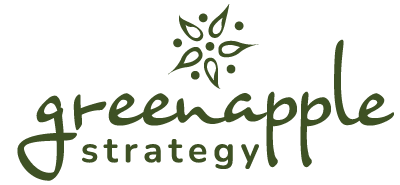Google search is a living, breathing entity, constantly evolving and adapting. What worked last year might not cut it in 2025. The rise of AI-powered search results has shifted how we think about content creation. Staying ahead of the curve is crucial for any business looking to thrive in the digital landscape.
At Green Apple Strategy, we understand that navigating SEO changes can feel overwhelming, especially for small and medium-sized businesses with limited marketing resources. That’s why we’re passionate about distilling the most important digital marketing trends and helping our clients incorporate them into their overall marketing strategy.
In this article, we’re highlighting some of the most impactful Google search statistics you need to know for 2025, tailored for both B2B and B2C businesses.
2025 Google Search Statistics for B2B Companies
1. 66% of B2B buyers in the US search online for products or companies before making a purchase. (SEOProfy)
FACT: Your potential B2B clients are doing their homework online before they even pick up the phone. They’re using search engines to actively research products and companies to find the best fit. This means a strong online presence is a necessity. If your website isn’t informative, easy to navigate, and optimized for search, you’re missing out on a huge chunk of potential business.
2. 30% of B2B companies prioritize SEO and place it as the second most popular marketing investment. (Statista)
SEO is not just about getting your website to rank higher; it’s about making sure the right people find you when they’re actively searching for what you offer. That’s why so many B2B companies are putting their money where their mouth is and investing in SEO. It’s a long-term play, but the payoff can be huge, attracting qualified leads and driving sustainable growth.
3. 57% of B2B businesses believe their SEO and content strategy generates more leads than any other marketing channel. (Gitnux)
Here’s a stat that really speaks to the power of SEO and content: over half of B2B businesses see SEO as their top lead generator. That’s because when you combine solid SEO with valuable, relevant content, you’re creating a magnet for potential customers. When people are searching for solutions, your content can position you as the expert, building trust and driving them further down the sales funnel.
4. Video is the media format that has the highest ROI, followed by images, blog posts, podcasts, or other audio content. (HubSpot)
In today’s fast-paced world, B2B buyers are looking for information they can consume quickly and easily. That’s where video content can shine. It’s engaging, informative, and can convey complex ideas in a digestible format. Whether it’s product demos, explainer videos, or customer testimonials, video content can significantly boost your ROI. And don’t forget about images, blog posts, and podcasts! They all play a role in creating a well-rounded content strategy that resonates with your B2B audience.
5. Businesses experience an average close rate of 14.6% from search engine leads, significantly higher than the 1.7% from traditional outbound methods. (LeadForensics)
Potential customers who are searching on Google are actively looking for solutions; they’re raising their hands and saying, ‘I need this!’ So, when they find you through search, they’re already primed to buy. It’s like having a pre-qualified audience knocking on your digital door, ready to do business. That’s why investing in SEO can be a game-changer for your bottom line.
2025 Google Search Statistics for B2C Brands
1. 46% of all searches on Google are for a local business or local service. (Search Engine Roundtable)
Think about your own search habits for a second. How often are you typing in ‘restaurants near me’ or ‘plumbers in [your town]’? As it turns out, nearly half of all Google searches are people looking for something local. That’s a massive opportunity for B2C businesses! If you’re not optimizing for local search, you’re missing out on nearly half of your potential customers.
2. After searching on a smartphone for something nearby, 76% of people end up visiting the business within one day. (Google)
This stat highlights the importance of mobile optimization and a strong local presence. If your website is slow or your information is hard to find on mobile, you’re losing out on immediate foot traffic. You want to be that top result searchers find on their phone so that they visit your business on the same day.
3. People are 70% more likely to visit a business with a complete Google Business Profile. (GPO)
Your Google Business Profile is like your digital storefront. And just like a physical storefront, you want it to look its best! That means filling out all the details, adding photos, and keeping your information up-to-date. Think of it as an online handshake. A strong, complete profile builds trust and encourages people to take that next step and visit your business.
4. Updating your existing content with new images and rewritten text can increase organic traffic by 111.3%. (SEOProfy)
You don’t always have to create brand-new content to see a boost in your SEO. Sometimes, a little refresh is all it takes. It’s like giving your old content a facelift, making it more relevant and engaging for both search engines and your audience. So, don’t forget to revisit your old blog posts and web pages—a little TLC can go a long way.
5. 73% of B2C marketers use keyword research tools for search engine optimization while working on content creation. (Content Marketing Institute)
When it comes to creating content that actually gets seen, keyword research is your best friend. This ensures that your content is not only valuable but also discoverable. It’s like speaking the same language as your potential customers, making it easier for them to find you online.
Your SEO Advantage: Partnering for Digital Success
Staying informed about the latest Google search statistics is essential for any business looking to succeed in the digital age. As a full-service marketing agency, we’re committed to helping our clients leverage every available tactic to achieve their growth goals.
The Orchard, our freelance team of specialists, includes seasoned SEO experts who can help local companies enhance their brand visibility and improve their online presence. If you’re looking to maximize your SEO efforts or improve your Google ranking, our team has the experience and tools to help. Contact us today to learn more about how we can help you achieve your marketing goals.











